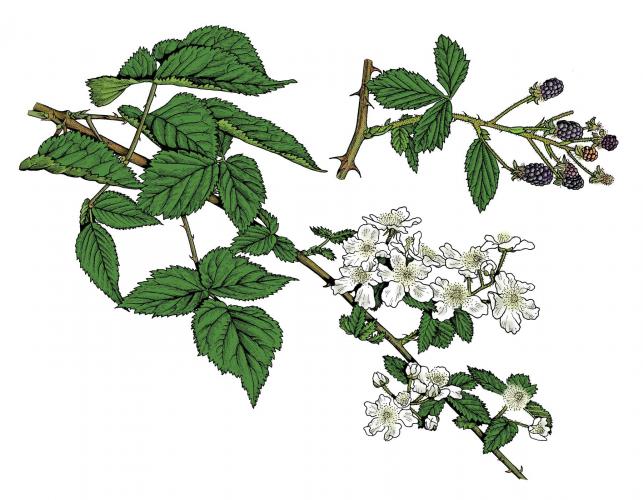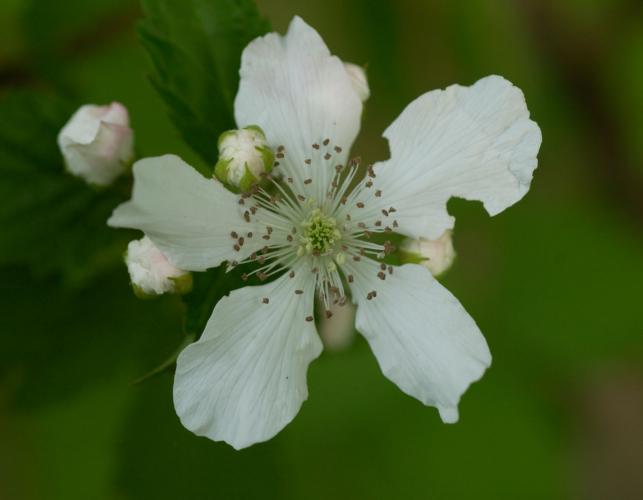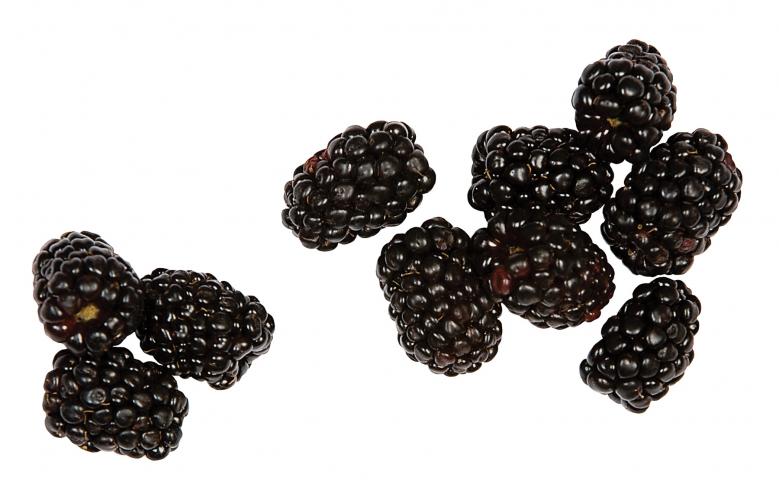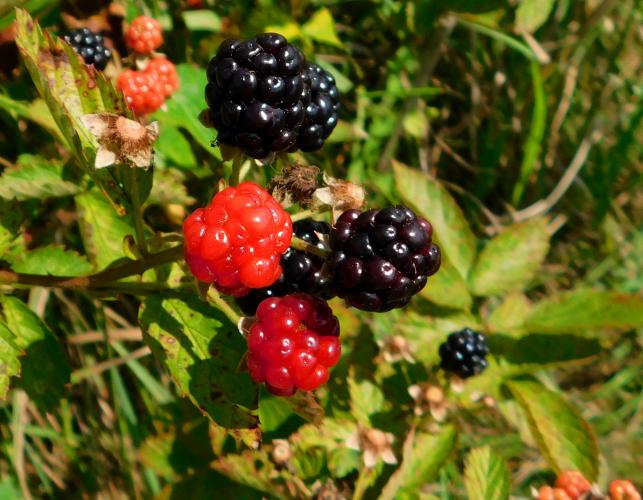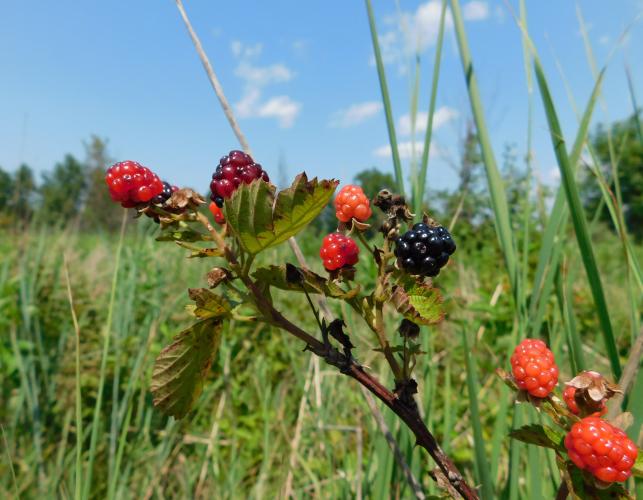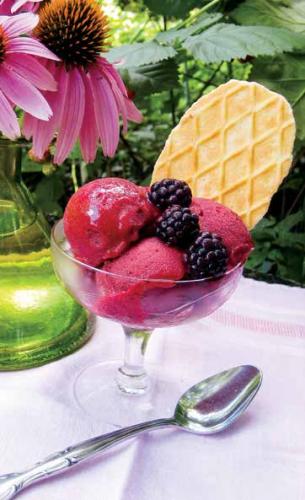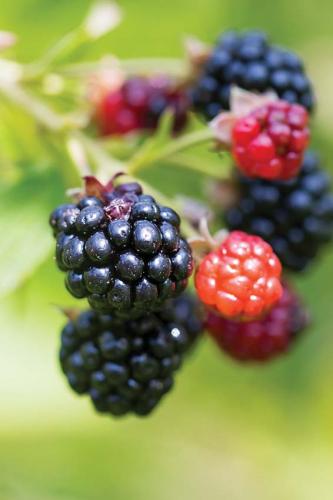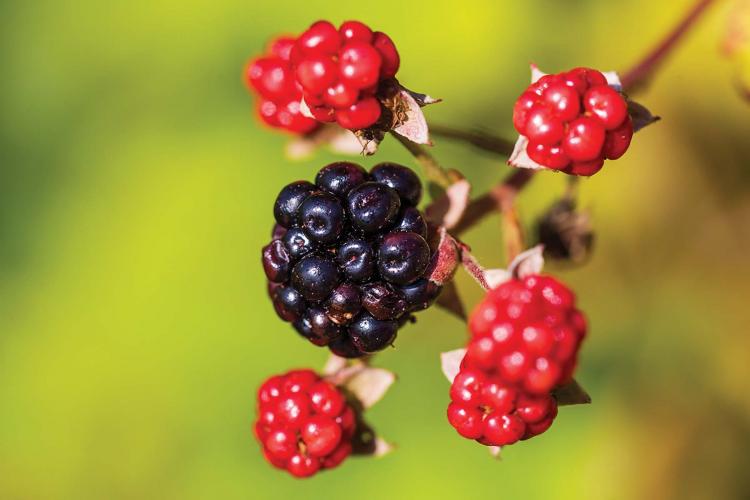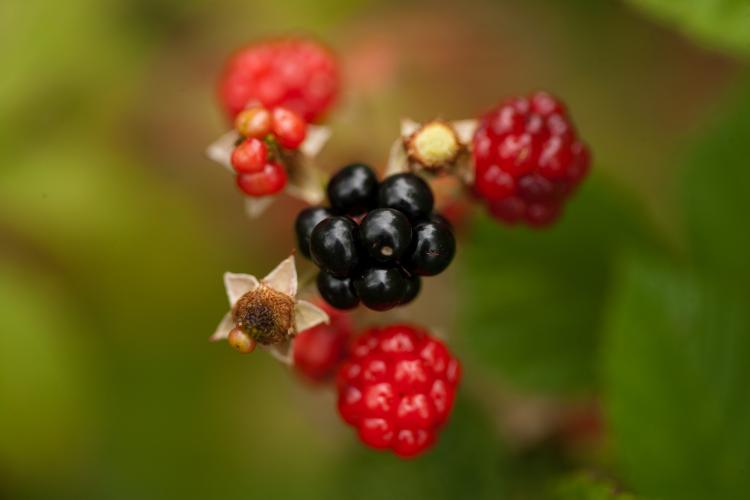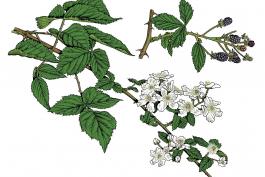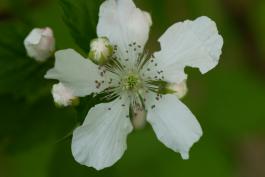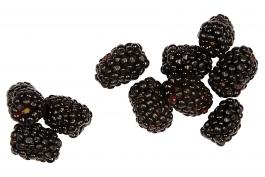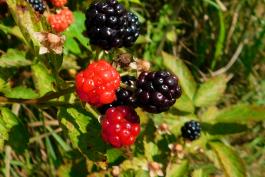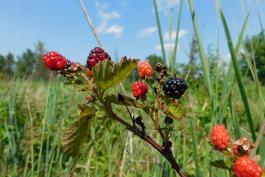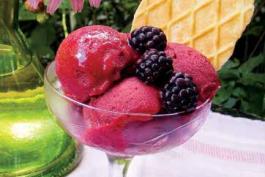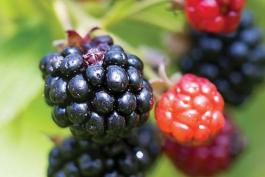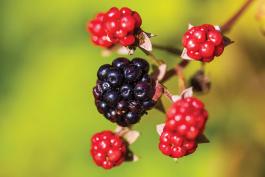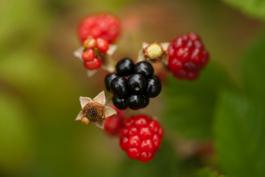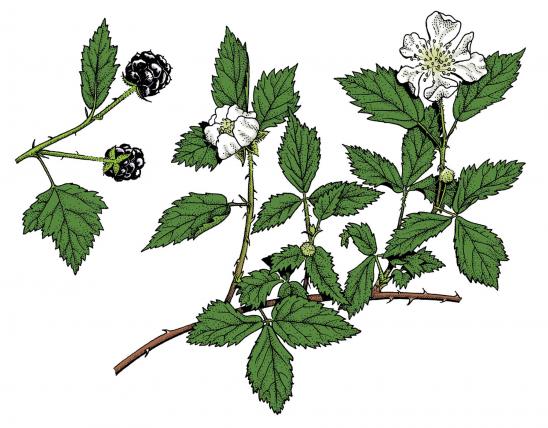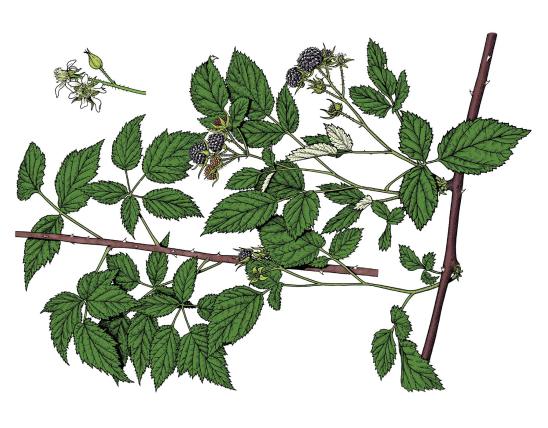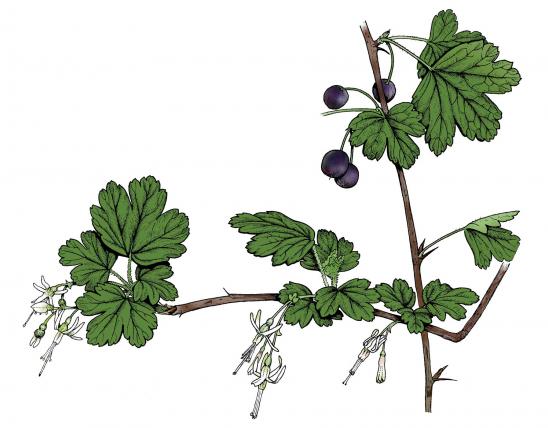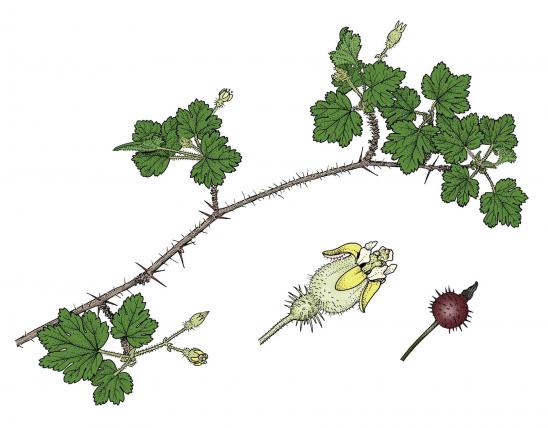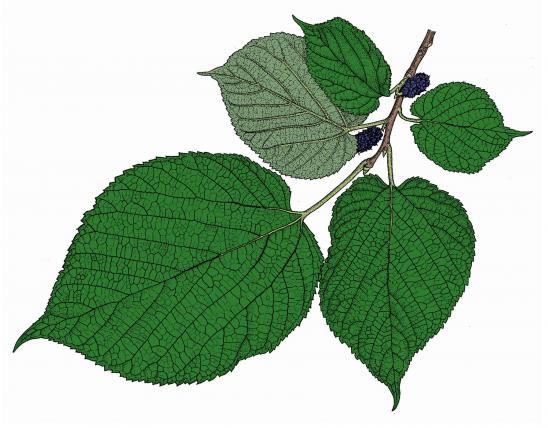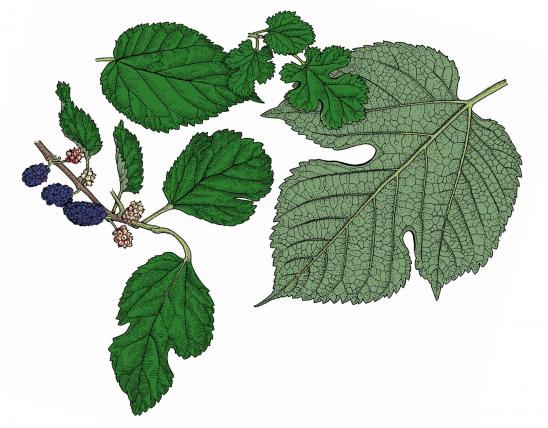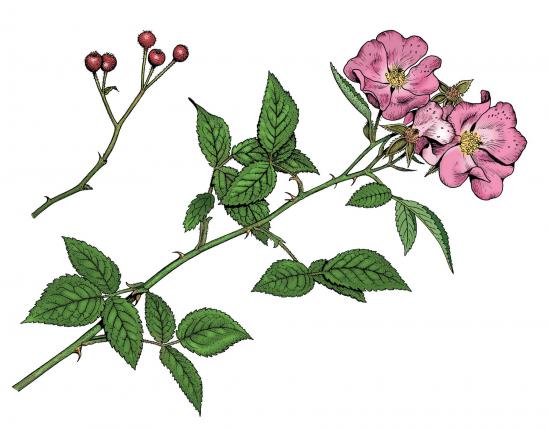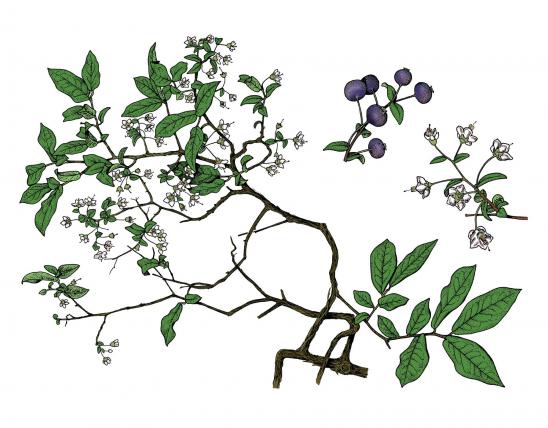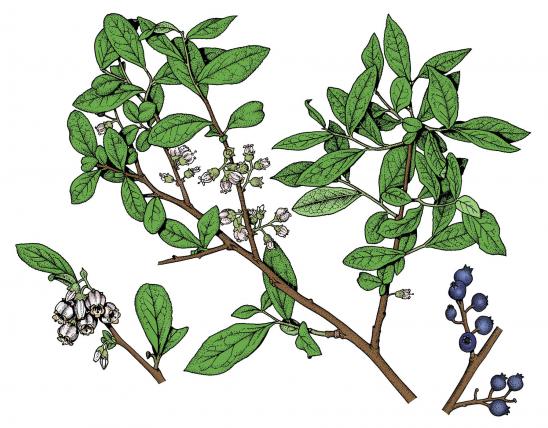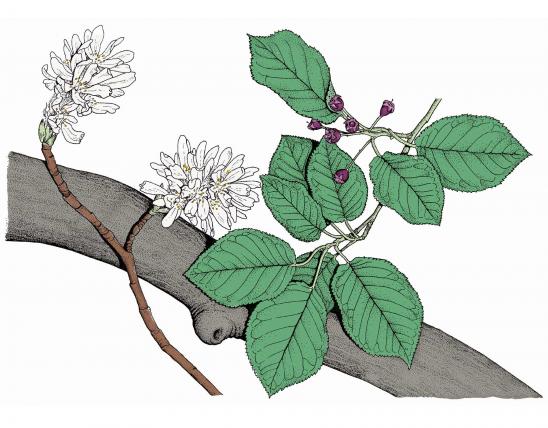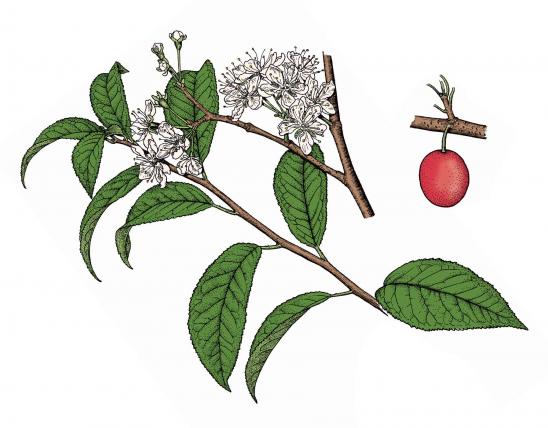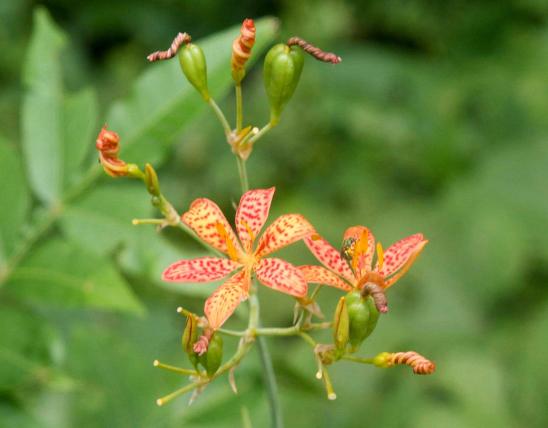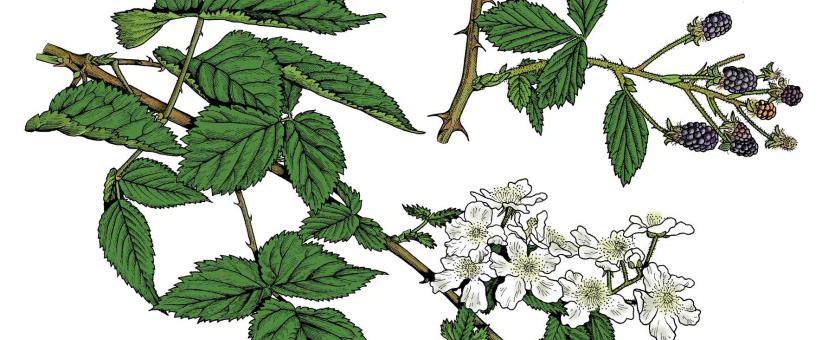
Common blackberry is an erect shrub, the branches occasionally to 8 feet and arching high or being supported by surrounding trees or shrubs.
Leaves are alternate, compound, with 3–5 leaflets; leaflets 2½–4 inches long, egg-shaped, edges coarsely toothed; medium green above, paler below. The end leaflet on primary canes are 3¼–5 inches long, or 2–3 times longer than broad.
Stems consist of canes with broad-based, recurved thorns. The primary (first-year) canes are green to reddish, ribbed, with numerous prickles. Flower canes (second year) are brown.
Flowers April–June, in clusters 4–5 inches long, or 2–4 times as long as broad, rather elongated and cylindrical. Flowers 6–12 and sometimes to 30, showy, ¾ inch across, petals 5, white oval; stamens numerous.
Fruits June–August. Abundant, deep violet to black, glossy juicy, sweet, globe-shaped or cylindrical, about ¾ inch long.
Similar species: Rubus is a large genus with about 30 species recorded in Missouri. Included in the genus are blackberries, raspberries, loganberries, dewberries, and brambles. The members of genus Rubus often interbreed and hybridize, and the canes often change their appearance between first and second growing seasons, making them a tricky group even for botanists to sort out.
Height: 5 feet; spread: 8 feet.
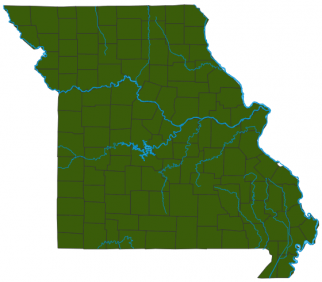
Widespread in Missouri.
Habitat and Conservation
Blackberry is widespread in Missouri and is found in rocky, open woods, along bluffs and fencerows, on glades, and in thickets, old fields, and open valleys. It often grows alongside gray dogwood, viburnum, and sumac.
This is only one of several species of blackberry in our state. Common blackberry is highly variable depending on genetic strain, growing conditions, and intergrading with related species and within its own species.
Many people cultivate (or encourage natural populations of) blackberries, raspberries, and related shrubs for their fruit.
Status
Native Missouri shrub bearing edible fruits. It and its relatives, including raspberries, dewberries, and other types of blackberries, are popular as cultivated native shrubs, because of their delicious fruit and wildlife value.
Human Connections
This fast-growing, colony-forming shrub is the original wild form from which many of the cultivated blackberries have been selected, and berry-pickers of all stripes brave scratches and chiggers as they collect these juicy berries for pies, preserves, or just plain eating.
“Please don’t throw me into the briar patch!” The real truth about blackberry bushes is that the prickles are worth braving — whether you’re a rabbit seeking shelter or a berry-picker hunting the delicious fruits.
Blackberries, raspberries, and other members of genus Rubus are very popular as edible landscaping plants. Many cultivated varieties and hybrids are available. They not only give us delicious fruits, but also provide benefits for wildlife: the flowers are excellent sources for pollinators, and the fruits are loved by songbirds and other animals.
Blackberries are nutritious and are a good source of vitamins C and K, manganese, fiber, and antioxidants, with a low glycemic index. Many people rank them as a "superfood," since they're high in nutrients, fiber, and antioxidants and low in carbohydrates and fat.
Blackberry recipes abound, and it seems that people come up with new culinary uses for them each summer. The possibilities are limited only by your creativity!
- Blackberry cobbler, pie, muffins, pancakes, juice, jam, and jelly are old standbys.
- Blackberries can also be used in ice creams, sorbets, smoothies, cocktails, infused water, milkshakes, and fools (a dessert made with whipped cream).
- You can make a sweet/savory blackberry sauce to use as a glaze or relish for pork, salmon, or chicken (think of a fruity barbeque sauce or a chutney).
- Cheese and fruits are a famous combination. You can have blackberries with baked brie, on a cheese plate, or melted together on flatbread as fruit-and-cheese pizza.
- Sprinkle blackberries on a green salad with feta or goat cheese and some nuts, dressed with a blackberry vinaigrette.
- Toss blackberries on your hot or cold cereal.
- Use blackberries in gelatin salads and desserts.
- Blackberries can be mixed with at least two other kinds of berries (such as blueberries, raspberries, and strawberries) to produce a favorite pie and jam combo called "bumbleberry."
Blackberries are woven into our culture. In the Ozarks, the terms "blackberry winter" and "blackberry squall" refer to a late-spring freeze or cold spell that occurs in May or early June, when the blackberry flowers are in bloom. The poetry of the phrase no doubt inspired a group of Ozark musicians recently to name their bluegrass band Blackberry Winter.
In 1947, folklorist Vance Randolph wrote of old-time Ozarkers near Marshfield, Missouri, who maintained that if it rains on May 23, there would be no blackberries to harvest. Other old-timers, near Rogers, Arkansas, maintained that even a light sprinkle of rain would ruin the blackberry harvest — but their magic date was June 2. Elsewhere, other Ozarkers said that rain, or even just thunder, on June 13 would ruin the berry harvest. Today, this folklore is just a curiosity, but it sure shows how highly people valued the annual blackberry crop!
Thickety colonies of thorny blackberry canes, greenbriers, wild roses, and other sticker bushes are often called briar patches. Joel Chandler Harris’s well-known “Tar-Baby” story, with its roots in African and Native American folklore, has a famous trickster character called Br’er Rabbit. In the story, Br'er Rabbit begs his ruthless captor, Br’er Fox, to please not fling him into the briar patch — which the mean-spirited fox does, not realizing the thorny thicket is exactly where the rabbit goes to escape his enemies. Many have suggested that this and similar nature tales were ways that enslaved Africans symbolically depicted a triumph over their own captors.
Ecosystem Connections
Blackberries provide food and cover for many wildlife species. They have a very high value for wildlife.
Deer eat the fruit and browse the tender canes. Other mammals that eat blackberry fruits or other plant parts include elk, foxes, bears, rabbits, raccoons, opossums, squirrels, mice, and chipmunks.
Much of the summer diet of turkeys is composed of the fruit. The list of other birds that eat blackberry fruits is long, including waxwings, tanagers, cardinals, grosbeaks, indigo buntings, crows, blue jays, sparrows, finches, towhees, blackbirds, grackles, orioles, thrashers, catbirds, mockingbirds, titmice, grouse, quail, pheasant, prairie-chicken, bluebirds, robins, thrushes, and more.
Birds and mammals that eat blackberry fruits typically poop out the still-viable seeds; in this way, they serve as a dispersal mechanism for the plant, so that the offspring blackberry bushes germinate in new locations away from the parent colony. Having offspring live in a variety of new locations increases the odds that at least some of them will survive and reproduce, continuing the genetic line, even if the parent colony is wiped out.
Many small animals, including rabbits, mice, and birds, find much-needed shelter within the maze of prickly stems in a blackberry briar patch. Several types of birds may nest in blackberry thickets.
The flowers of blackberry (very similar to wild rose or strawberry flowers) are a favorite nectar source for many pollinator insects, including a very wide variety of native bees in several families. Butterflies, beetles, flies, wasps, ants, and other insects are attracted to the pollen and nectar.
A bewildering variety of insects consume the leaves, sap, stalks, or other plant parts of blackberry bushes. Insects that chew the leaves include various species of leaf beetles, grasshoppers and katydids, and several types of moth and butterfly caterpillars. Insects that suck the sap include various species of plant bugs, stink bugs, aphids, leafhoppers, and treehoppers. Insects that eat the canes include certain types of metallic wood-boring beetles and longhorned beetles.
With all the pollinating, leaf-eating, and sap-sucking insects they attract, a colony of blackberry bushes becomes a kind of mini-habitat. Mantids, ambush bugs, robber flies, crab spiders, and other insectivores hunt the herbivore insects. All these protein-rich insects are attractive to birds, which are especially hungry for insects during nesting season.
